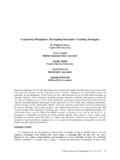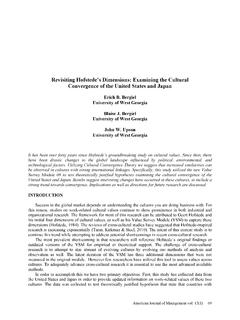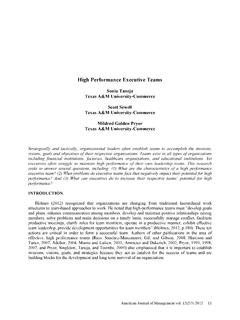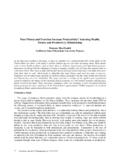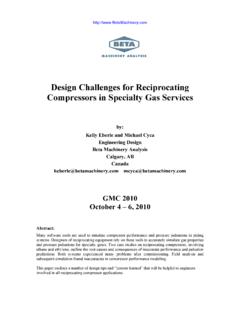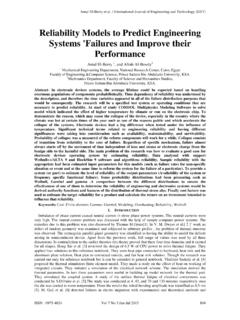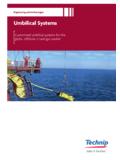Transcription of Practical Managerial Decision Making Tools: …
1 Practical Managerial Decision Making Tools: operations research Eunjin Lee New Mexico State University Joon-Yeoul Oh Texas A&M University Kingsville Edward Pines New Mexico State University The purpose of this paper is to advocate the Managerial practice of Making decisions based not only on intuition, but intuition coupled with quantitative analysis. operations research (OR) or Optimization is one of the leading Managerial Decision science tools used by profit and nonprofit organizations such as Ford Motors, AT&T, Merrill Lynch, Samsung, US Army Recruitment and Olympic games organizing committees. Such technique is utilized by functional groups such as Industrial Engineering in effort to support operations Managers to make economically feasible decisions on a range of systematic challenges.
2 In order to make the effective yet efficient decisions, managers must have fundamental understanding of the Decision science tools utilized in developing set of recommendations to choose from. With this motivation, this paper includes brief discussion on background of OR, its methodology and publicly reported benefits of implementing OR and challenges in OR. Since the purpose of this literature is to disseminate information to advocate the importance of scientific approaches in the process of Managerial Decision - Making , research and academic disclosures are intentionally omitted. INTRODUCTION The main responsibilities of operations management are to manage and operate as efficiently and effectively as possible with the given resources.
3 With today's global market, and large-scale systems, achieving the optimum performance is a challenge. Many Decision science tools are available for all levels of Decision makers. Quantitative methods such as operations research (OR), which comprises of simulation, linear and nonlinear programming, queueing theory and stochastic modeling, are well-accepted techniques by both research and practice communities. Large profit organization such as Ford Motors (Chelst, Sidelko, Przebienda, Lockledge, & Mihailidis, 2001), Merrill Lynch (Atschuler et al., 2000), AT&T (Ambs et al., 2000) and Journal of Applied Business and EconomicsSamsung (Leachman, Kang, & Lin, 2002) reported millions dollars of savings with OR.
4 OR has a strong presence in nonprofit organizations as well. US Army Recruiting Office (Knowles, Parlier, Hoscheit, & Ayer, 2002) and Warner Robins Air Logistics Center (Srinivasan 2006) won the world s most prestigious award, 2006 Franz Eldelman Award for outstanding achievements of OR. Functional entities such as Industrial or Systems Engineering uses both methodologies to provide feasible alternatives for operations mangers to decide on. An important component of Decision - Making process is verifying and validating alternatives, which typically involve Decision makers and engineers or analysts. Thus, high-level understanding of the tools or methodologies used for recommendations is essential in Making the effective Decision for achieving the organization s common goal of maximizing profit.
5 In the following sections a brief background on operations research is discussed along with selected OR techniques including Linear Programming, Discrete Event Simulation and Queueing Theory, and a typical problem solving procedures for OR. Also, Success cases of OR from both Practical and research perspectives are discussed. The paper is concluded with a brief summary of the materials discussed. The primary motivation and purpose of this literature is to disseminate knowledge; hence, neither academic nor research disclosures are conversed. OVERVIEW OF operations research During World War II, a set of diversified scientists from England and the United States developed scientific methods of planning military logistics such as most economical method of disseminating resources to various war sites.
6 The scientists developed a famous quantitative method for such operations and named it operations research (OR) or often referred as Managerial or Decision science (Hillier, 2005; Turner, Mize, Case, & Nazemetz, 1993). With its proven successes, OR spread to private sectors promptly. With rapid improvements in computer technology, to this date, OR is one of the most powerful Decision Making tools in the operations Management and Industrial Engineering disciplines. Murty defines operations research as a discipline that deals with techniques for system optimization (1993). OR s primary objective is to find optimal or near optimal solution to complex business to engineering problems.
7 operations research techniques are used to answer the common Managerial questions such as: How many and much resources are required to meet the key performance target? Which alternatives require minimum cost and generate maximum profit? What is the optimal resource schedule to minimize overhead cost? What is the maximum and minimal resource utilization level? Where are primary and secondary constraints or bottlenecks? What range of queue and process time is allowed to achieve goal? What is the current capacity and required capacity to meet the goal? What are the anticipated risks for accepting or Making new product or model? OR evaluates the system of interest globally. It considers all factors or all factors identified the Decision makers.
8 For example, to maximize or optimize production performance, characteristics of each or management identified areas such as rate of production per work station, rate of material usage per product or program, average time spent in transition and available capacity in terms of space are considered in the OR models. Viewing such system with the philosophy of local efficiency, the management will be only interested in maximizing production performance at a workstation, not entire work stations. Numerous OR techniques are available to use; however, the scope of this paper is limited to the following commonly used techniques: Linear (LP), Discrete Event Simulation (DES) and Queueing Theory (QT).
9 Combination of such techniques in optimization studies, especially in practice. Discussions of LP, DES and QT techniques are in the following sections. Linear Programming Linear programming techniques are considered as mathematics based Decision - Making tool. Such technique requires two fundamental types of functions, objective and constraints, that is developed to generate closed-form solution. In a typical OR problem, the objective function, often expressed as Z, is formulated to determine the maximum profit while minimizing cost with given set of rules or constraints such as business policies, resource availability, preventative maintenance schedule, transportation distance or time and capacity.
10 Consider a bank that is expecting an increase of customers due to the new investment programs, which recently were introduced to the customers. Thus, the operations management team has a task to determine the number of resources, tellers specifically, to obtain to sustain the current customer satisfactory level for its 24-hours operations with minimal cost. The following set of data was requested by and provided to a cross-functional team responsible for the analysis. This is a modified version of Hiller s (2005) the Union Airways Personnel Scheduling Problem. Table Personnel Scheduling Data (Based on 5 days per week, 8 hours per day) TIME MINIMUM NUMBER 1 PERIOD 2345OF TELLERS NEEDED8:00 - 12:00 x 64 12:00 - 4:00 x 111 x 180 4:00 - 8:00 8:00 - 12:00 78 xx12:00 - 4:00 19 xx25 4:00 - 8.

